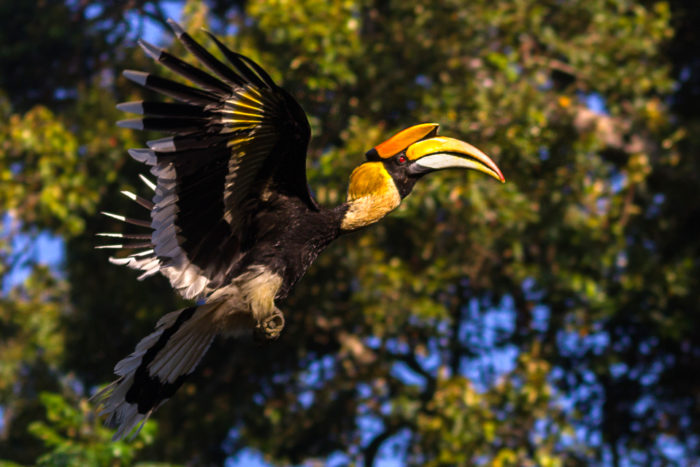The Great Indian Hornbill, also known as Great Pied Hornbill, is one of the larger members of the hornbill family.
Its magnificent size and superb colour has made it an integral part of many tribal cultures and rituals in Northeastern India.
This article will give details about the Great Indian Hornbill within the context of the IAS Exam.
Details about the Great Indian Hornbill
A prominent feature of the Great Indian Hornbill is the bright yellow and black casque on its bill. The casque is U-shaped while seen from the front
The males have a black casque at its back and front underside, while it is reddish in colour for the back casque in females.
A sound produced by the wing beating of the Great Indian Hornbill can be heard from a long distance. Its flight consists of stiff flaps foollowd by glides enabling them to fly at great heights over forests.
They are referred to as ‘engineers of the forests’ as they play a crucial role in dispersing seeds of the tropical forests, thus preserving its ecological balance.
For notes on UPSC Environment and Ecology, visit the linked article.
Great Indian Hornbill:- Download PDF Here
Further details about the Great Indian Hornbill is given in the table below:
Details of the Great Indian Hornbill
| Length | 95-130 cm |
| Latin Name | (Buceros bicornis) |
| Wingspan | 152 cm |
| Weight | 2 to 4 kg |
| Habitat | India, Bhutan, Nepal, Mainland Southeast Asia and Indonesian island of Sumatra |
| Diet | Frugivorous, but also will prey on small reptiles, mammals and birds if and when the opportunity is right |
Cultural Significance of the Great Indian Hornbill
The great hornbill is the state bird of Kerala and Arunachal Pradesh in India. The Great Indian Hornbill is also considered sacred among the tribal cultures of Nagaland. To commemorate this, the Hornbill Festival is celebrated every year from December 1 to 10. It was first celebrated in 2000.
But it is this reverence that has threatened the population of the Great Hornbill. The beaks and heads of these birds are used as head-dresses and charmes while its flesh is believed to possess medicinal properties. Tribesmen in Nagaland and other parts of Northeast India also wear feathers and skulls as decorations. There are other festivals among the tribes of Nagaland which are considered incomplete without a hornbill feather.
Additionally illegal logging is also cause for its declining population
To preserve the vulnerable population of the Great Indian Hornbill, conservation efforts have attempted to provide feathers from captive birds and ceramic casques to substitute the actual ones.

To know more about Biodiversity in general, visit the linked article.
For more information about upcoming Government Exams, visit the linked article. More exam-related preparation materials will be found through the links given below
Related Links

Comments